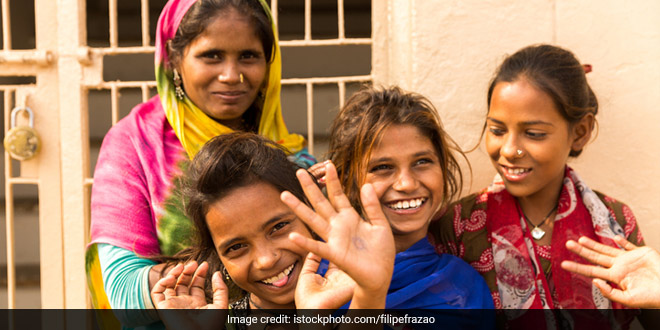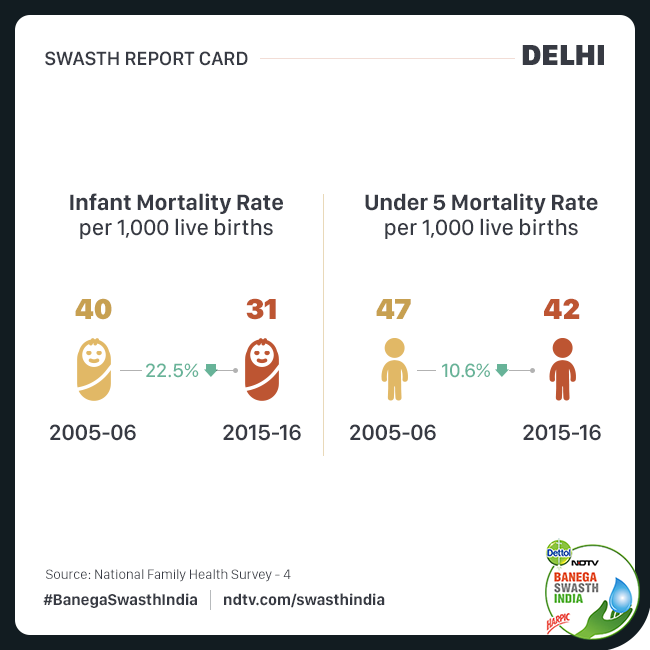New Delhi: The national capital Delhi is home to over 1.6 crore (16,787,941) individuals, according to 2011 census. Out of total population of Delhi, 97.50 per cent (16,368,899) people live in urban regions and the remaining 2.50 per cent reside in rural areas. Since last few years, Delhi has been grappling with various health issues like dengue, air pollution and was even given the title of World’s Most Polluted capital city by the Greenpeace’s study ‘2018 World Air Quality Report’. While the city is grappling with the issue of air pollution, and has managed to bring down the number of dengue cases from 5,867 in 2015 to 2,798 in 2018, there are various other health parameters like malnutrition and diarrhoea that needs immediate attention.
Here’s a quick look at how Delhi fared in different health parameters:
- Infant Mortality Rate (IMR): Infant mortality rate (IMR) is the number of deaths per 1,000 live births of children under the age of one. According to the National Family Health Survey (NFHS) 4, the infant mortality rate dropped from 40 in 2005-06 to 31 in 2015-2016, a drop of 22.5 percent. This is less than the 28 percent drop seen at an all India level during the same period.
- Under-Five Mortality Rate (U5MR): Under-five mortality rate (U5MR) is the probability of death between birth and five years of age, expressed as per 1,000 live births. In Delhi, U5MR has declined from 47 in 2005-2006 to 42 in 2015-2016, which is just a drop of 10.6 percent compared to the 32 percent drop seen at an all India level for under-five mortality rate.
- Malnutrition: Malnutrition caused by under nutrition often leads to stunting (low height for age), wasting (low weight for height), and hampering an individual’s growth due to being underweight (low weight for age). While the cases of stunting among children under 5 years of age has come down from 42.2 per cent (2005-06) to 31.9 per cent (2015-16) which is a drop of 10.3 percentage; marginally better than the 9.6 per cent drop seen at an all India level (from 48 per cent to 38.4 per cent in the same period). Instances of wasting in Delhi, has increased marginally by 0.5 per cent (from 15.4 per cent in 2005-06 to 15.9 per cent in 2015-16), this increase is less than the 1.2 per cent increase seen in case of wasting at an all India level.
In case of underweight children Delhi saw a slight increase of 0.9 per cent (from 26.1 per cent in 2005-06 to 27 per cent in 2015-16) whereas in the same period at an all India level, the cases of underweight children declined by 6.7 per cent (from 42.5 to 35.8 per cent). - Anaemia Among Children And Women: Anaemia is the reduced oxygen carrying capacity due to less Haemoglobin (Hb) available in the body. Anaemia can be acute to fatal and can pose serious health hazards to an individual’s life. Overall the country did show a tad improvement as anaemia decreased by 10.8 per cent in children and 2.2 per cent in women. But as per the data available under NFHS 4, Delhi went against the trend and anaemia cases among children (6-59 months) increased by 2.7 per cent and among women (15-49 years) the upsurge was by a significant 10 per cent.
To bring down the cases of anaemia among children, Deputy Chief Minister Manish Sisodia flagged off ‘Anaemia Mukt’ vans as part of the Anaemia Mukt Bharat, a centre-run programme from the Assembly complex on Monday (September 23).“These vans will go to every district of Delhi and collect blood samples of children. Along with this, data will also be collected so that children can be properly treated in time. This is an awareness cum action plan to fight anaemia among children by our government,” said Mr Sisodia, as quoted by PTI.
- Diarrhoea: In Delhi, both the cases and deaths due to acute diarrhoeal diseases increased in 2018 when compared to 2017, as per the National Health Profile 2019. In 2017, Delhi contributed by 0.95 per cent (1,28,585) to total diarrhoeal cases in India (1,34,16,748) whereas in 2018, Delhi’s contribution was marginally higher at 1.18 per cent to the total diarrhoeal cases (1,31,94,775 ) in the country. The number of deaths due to acute diarrhoeal diseases stood at 127 in 2018 as opposed to 117 in 2017.
Note: National Family Health Survey (NFHS-4) fieldwork for Delhi was conducted from February 2016 to September 2016 and gathered information from over 6 thousand (76,233) households, 5,914 women, and 672 men.




















